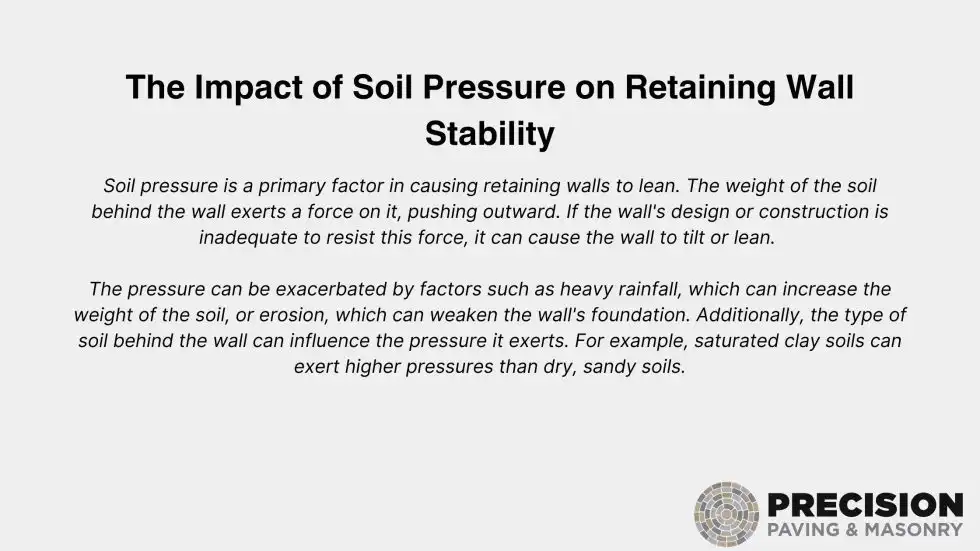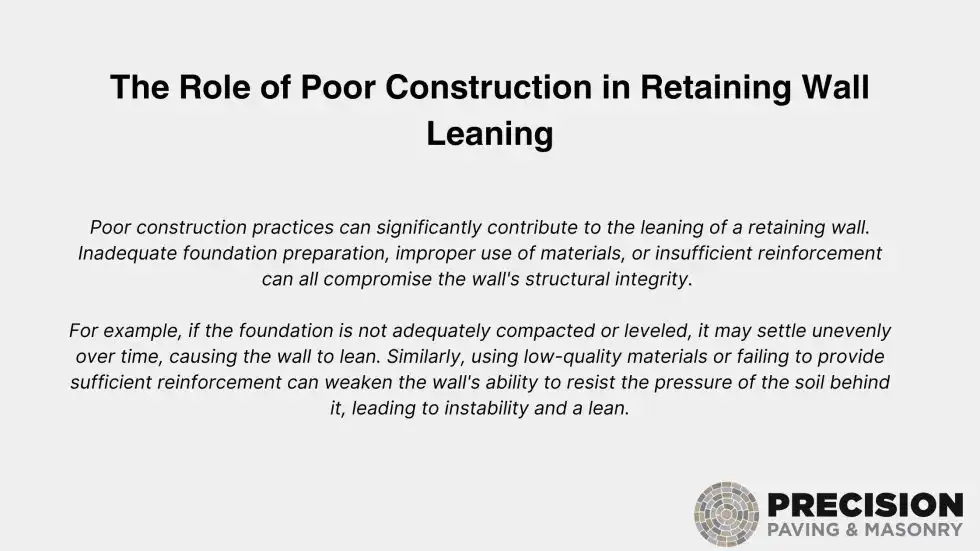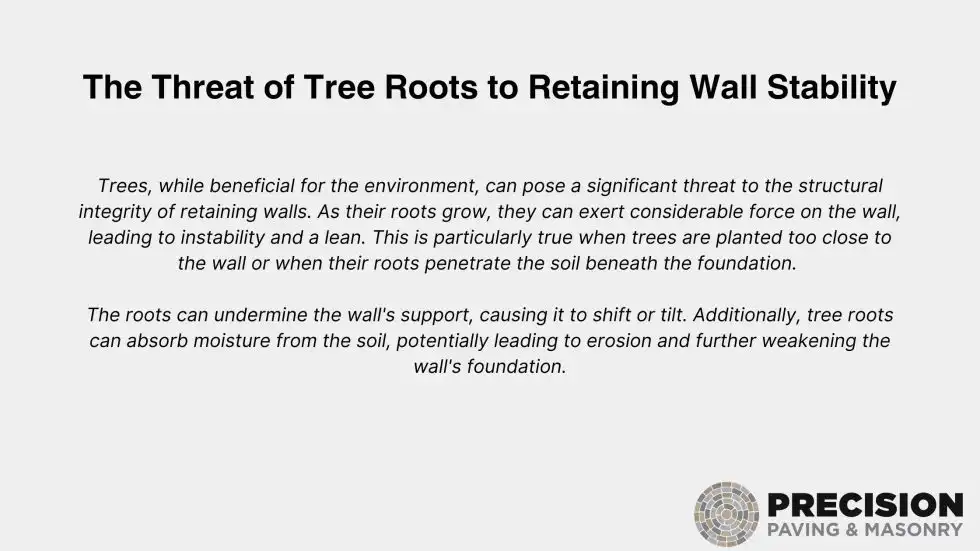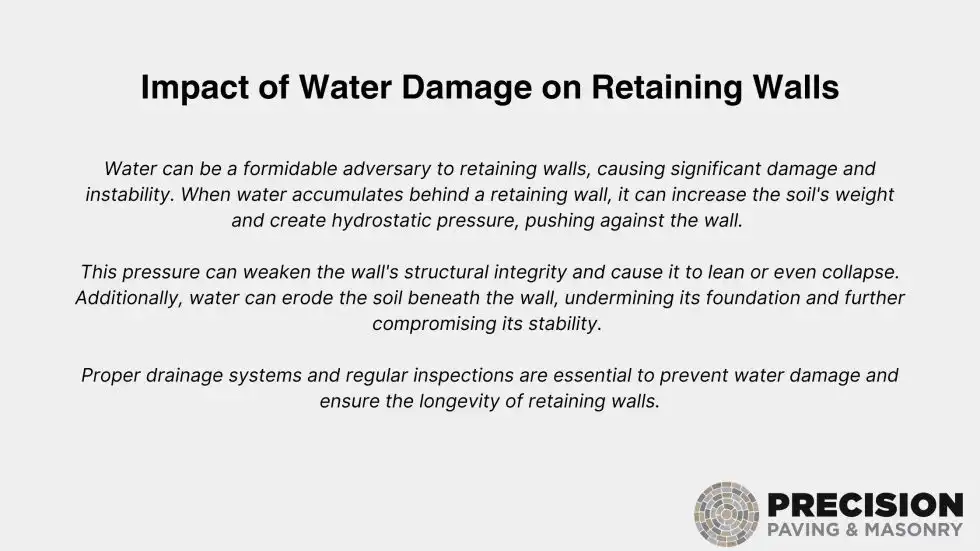Key Takeaway:
Identify the Cause: Examine soil pressure, poor construction, tree roots, or water damage.
Assess the Damage: Check for leaning, cracks, or bulging areas.
Apply Proper Repairs: Excavate, reinforce, realign, and improve drainage.
Ensure Safety: Wear protective gear and confirm wall stability before working.
Maintain Stability: Conduct regular inspections, seal cracks, and manage surrounding drainage.
Introduction
A leaning retaining wall compromises safety and appearance. Identify the causes, follow repair steps, and ensure proper maintenance to restore stability and protect your property.
Overview
A leaning retaining wall can be a major concern for any homeowner. Not only does it affect the appearance of your landscape, but it can also pose a safety risk if left unaddressed. Understanding how to fix a retaining wall that is leaning is essential to maintaining the stability and beauty of your property.
This guide will walk you through the steps to identify the causes of a leaning wall, assess the damage, and safely repair it. With some basic tools and materials, you can restore your retaining wall to its original strength and appearance.
What Causes a Retaining Wall to Lean?
A leaning retaining wall can be caused by several factors:
Soil Pressure
One of the most common reasons is excessive soil pressure. This can happen due to poor drainage or heavy rainfall, causing the soil behind the wall to become too heavy and push against it.
- Overloading: If a retaining wall isn’t engineered to support the weight and pressure of the soil it holds back, it may start to lean. This can happen if additional loads, like heavy landscaping, are added near the wall.
- Soil Expansion: Certain types of soil, such as clay, expand significantly when they absorb water. This expansion creates extra pressure on the wall, which can eventually cause it to lean or crack, especially if the wall was not designed to handle this type of stress.

Impact Of Soil Pressure On Retaining Wall
Poor Construction
Another cause is poor construction. If the wall wasn’t built using the right techniques or materials. It might not be strong enough to hold back the soil.
- Inadequate Foundation: A strong foundation is crucial for any retaining wall. If the foundation was poorly designed, improperly compacted, or inadequately reinforced, it may not be able to hold the wall securely, leading to tilting or failure over time.
- Soil Settlement: Over the years, the soil beneath the wall may start to settle or compact unevenly. This uneven settlement can cause sections of the wall to tilt, crack, or even sink, contributing to a noticeable lean.

Role of Poor Construction in Retaining Wall Leaning
Tree Roots
The growth of nearby tree roots can also push against the retaining wall, causing it to lean.

Threat Of Tree Roots To Retaining Wall Stability
Water Damage
Lastly, water damage can lead to a leaning wall. Water seeping into the wall can cause erosion, weakening the structure and making it more likely to lean.

Impact of Water Damage on Retaining Walls
Understanding these causes is the first step in fixing a leaning retaining wall. Identifying the reason behind the problem will help you choose the repair method.
Assessing Damage: Key Signs of a Leaning Retaining Wall
To determine if your retaining wall is leaning, look for these signs
Check for Tilting: Notice if the wall is leaning forward or backward.
Inspect for Cracks: Look for horizontal or step-like cracks along the wall surface.
Observe Bulging Sections: Identify any outward bulges that indicate pressure buildup.
Monitor Soil Movement: Watch for soil shifting or gaps forming behind the wall.
Evaluate Drainage Issues: Check for poor water flow or pooling that may weaken the structure.
By identifying these signs early, you can take the necessary steps to fix the wall before the damage worsens.
Safety Precautions: Ensuring a Secure Work Environment
Before starting on how to fix a retaining wall that is leading. It is important to prioritize safety. Here are some essential precautions:
- Personal Protection Equipment: Gloves, safety glasses, and hard hats should be worn all the time to safeguard yourself from debris and potential risks.
- Structural Integrity: Assess the structural stability of the wall before any repairs. This will ensure that it is safe to work around and will not collapse unanticipatedly.
- Emergency Preparedness Plan: In case of the collapse of a wall or any other accident, there should be an emergency preparedness plan in position for escape purposes and a first aid kit kept within reach.
By observing these guarantees, you could create a safer environment when fixing a leaning retaining wall.
Gathering the Right Tools and Materials
In addressing how to deal with a leaning retaining wall, it is useful to gather all the necessary tools.
- Tools: Spades, wheelbarrows, mallets, and an assortment of masonry tools are essential.
- Supplies: Collect some rock chippings, sand, reinforcement bars, and cement for this purpose.
- Safety Gear: Remember to wear helmets, gloves, and goggles as well.
Step 1: Digging out soil to start fixing a leaning retaining wall
The first part involves digging up soil around the affected area before setting it right.
- Clearing Area: Begin by removing plants, trash or loose dirt from near your wall.
- Excavating Soil: Remove soil from behind and around the crooked wall so that you can have space for repairs.
- Leveling Ground: Ensure that ground is even and safe before proceeding further forward.
Step 2: Reinforcing materials for a leaning retaining wall
How you may rectify a tilting retaining wall should be dependent upon its strength.
- Putting in Rebar: Set steel rods (rebar) into the pit where you intend to reinforce the structure.
- Applying Concrete: This will fortify the base and sides of the walls once cement is poured on top of the rebar.
- Allowing Cure Time: During this period allow for proper curing so as to achieve maximum strength.
Step 3: Building foundation again when having to lean retaining walls
For any efforts meant at correcting bending retaining walls, these must be founded strongly.
- Removing Damaged Sections: Take away any spoils or loose parts of the wall with extreme caution.
- Laying New Foundation: Construct a new, strong foundation made up of concrete or stone.
- Ensuring Leveling: Make certain that the new foundation is leveled and stable to support the wall properly.
Step 4: Realigning the Retaining Wall
- Repositioning the Wall: Gently move the wall back into its correct position.
- Securing the Wall: Prop up or anchor it while you continue working on it.
- Checking Alignment: Assure yourself that it is straight, and correctly positioned before fixing it permanently.
Step 5: Backfilling and Compacting
Proper backfilling and compacting are two major approaches to deal with how to fix a retaining wall that is leaning.
- Adding Backfill: Gradually add a fill material behind the wall which will provide support for it.
- Compacting Soil: Compact different layers of soil so as not to cause any further displacements in the future which can make it unstable again.
- Ensuring Drainage: Install drainage systems (pipes) or gravel around these walls which will help prevent flooding situations in the future after heavy rains among other destructive activities caused by water close to these structures.
Retaining walls can lean towards the areas they are holding back. It is therefore important to understand how to fix a leaning retaining wall in order to ensure that it remains stable for many years.
Final Touches: Finishing and Maintaining the Restored Retaining Wall
For a detailed guide on the repair process, see our article on How to Repair a Retaining Wall. Completing the restoration and ensuring long-term stability is crucial when fixing a leaning retaining wall. These are the final steps:
- Sealing Cracks: A check has to be done after all other repairs have been completed to find any cracks or gaps left behind on your wall. These spaces should then be filled using a quality sealant that will not allow water in them hence preventing future damage.
- Surface Treatment: Apply a protective coating on the surface of this structure. This will help prevent weathering thereby increasing its lifespan. Depending on what material your wall is made of, choose an appropriate coat that best suits it, for instance, concrete or brick.
- Regular Inspections: Keep checking continuously for possible cracks, water buildups, or even when you see it inclining slowly so as not to need heavy-duty construction later on.
- Maintenance Tips: Do not grow dense vegetation around the wall for roots exert pressure against it. Make sure there is the proper drainage system that prevents the accumulation of water behind this barrier. Following heavy rains or freezing periods, monitor such cases because they could affect how strong this edifice stands.
These final touches and maintenance tips will enable you to have a safe and stable retaining wall. However, it’s important to note that knowing how to fix a leaning retaining wall includes immediate repairs as well as long-term care and regular maintenance.
FAQs
Q. Is it possible to fix a leaning retaining wall?
To resist tilting forward from behind pressure, one needs to rebuild its footing so that it has something to hold onto. In other cases, you might make backfill structures that bite into the hillside and refuse to be pulled forward which will serve as anchors on the wall structure itself.
Q. How to Repair a Retaining Wall That is Leaning?
Commence by eliminating any unfastened or shattered blocks and after that use a level for ascertaining the correct inclination of the wall. The new concrete blocks can be put in place and then attached by a good firm adhesive or cement. Finally, backfill the area behind the wall with compacted soil to give it further support.
Q. What Should You Do if Your Retaining Wall is Falling Down?
To beef up the buttress of the wall, you can shift some of its shear force to its base at which it touches down on earth. This might entail either extending the platform of the base or pouring a concrete mixture to beef up the footing. Other options include using anchor bolts or tiebacks.
Q. Why Is My Retaining Wall Tilting?
This compact ensures that your retaining wall’s soil is not loose and will not move in the future resulting in falling towards one side. Inappropriate compaction may create empty spaces within the soil leading to instability and dislocation of your retaining wall.
Q. How much to fix a retaining wall?
A: The cost to fix a retaining wall can vary widely based on the extent of the damage and the materials used. For a more accurate figure, you can contact Precision Paving & Masonry.
Q. How much to build a retaining wall?
A: Building a retaining wall typically depends on factors like materials, height, and length. For specific pricing, reach out to Precision Paving & Masonry.
Q. How much to build a block wall?
A: The cost to build a block wall usually varies based on the size and type of blocks used. Contact Precision Paving & Masonry for an estimate based on your needs.
Q. How to replace a retaining wall?
A: To replace a retaining wall, start by removing the old wall. Prepare the site by leveling the ground and creating a solid foundation. Then, you can construct the new wall using your chosen materials.
Q. How to fix a retaining wall?
A: To fix a retaining wall, assess the damage first. If there are cracks, you can fill them with concrete or epoxy. For leaning walls, you may need to shore up the foundation or address drainage issues.
Q. How to fix a retaining wall that is leaning?
A: To fix a leaning retaining wall, you can add support by installing vertical braces or underpinning the wall’s base. It’s important to ensure proper drainage to prevent further leaning.
Q. How much does it cost to fix a retaining wall?
A: The cost to fix a retaining wall varies based on the type of repairs needed. For an accurate estimate, contact Precision Paving & Masonry, who can assess your specific situation.
Conclusion
Fixing a leaning retaining wall is crucial for maintaining your property’s aesthetics and safety. By determining the causes, and assessing the extent of damage, repair steps must be followed while carrying out appropriate maintenance for continued strength of your walls over the years. Periodic inspection and performance of routine tasks can help curb future eventualities while safeguarding your investments.
In case you’re unsure about handling this task individually or require professional support, feel free to call our skilled team. We are available for wide-ranging services such as repairing leaning retaining walls among others that guarantee their durability. Book an appointment through this website now for a consultative meeting aimed at securing your compound.
